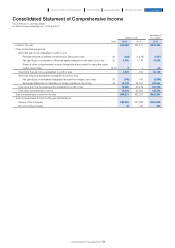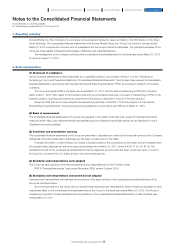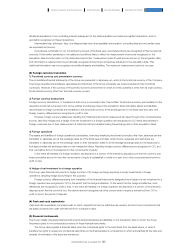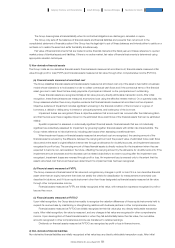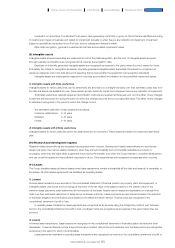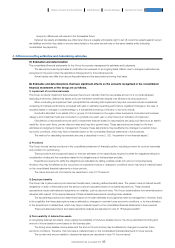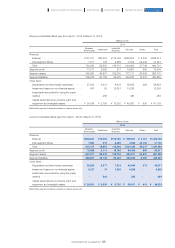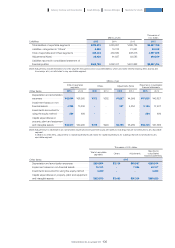Konica Minolta 2015 Annual Report Download - page 94
Download and view the complete annual report
Please find page 94 of the 2015 Konica Minolta annual report below. You can navigate through the pages in the report by either clicking on the pages listed below, or by using the keyword search tool below to find specific information within the annual report.
Goodwill is not amortized. It is allocated to an asset, cash-generating unit (CGU) or group of CGUs that are identified according
to locations and types of business and tested for impairment annually or when there is any indication of impairment. Impairment
losses on goodwill are recognized in profit or loss, and no subsequent reversal is made.
After initial recognition, goodwill is presented at cost less accumulated impairment losses.
(9) Intangible assets
Intangible assets acquired separately are measured at cost at the initial recognition, and the cost of intangible assets acquired
through business combinations are recognized at fair value at the acquisition date.
Expenses on internally generated intangible assets are recognized as expense in the period when incurred, except for those
that satisfy the criteria for recognition as assets. Internally generated intangible assets that satisfy the criteria for recognition as
assets are stated at cost in the total amount of spending that is incurred after the assets first met recognition standards.
Intangible assets are subsequently measured at cost less accumulated amortization and accumulated impairment losses.
1) Intangible assets with finite useful lives
Intangible assets for which useful lives can be determined are amortized on a straight-line basis over their estimated useful lives from
the date the assets are available for use. These assets are also tested for impairment whenever there is any indication of impairment.
Estimated useful lives, residual values and amortization methods are reviewed at fiscal year-end, and the effect of any changes
in estimate are accounted for during the period in which the change occurred and on a prospective basis. The effect of any changes
in estimate is recognized in the period in which the change occurs.
The estimated useful life of major assets are as follows:
Customer relationships: 3–15 years
Software: 3–10 years
Others: 3–10 years
2) Intangible assets with infinite useful lives
Intangible assets for which useful life cannot be determined are not amortized. These assets are tested for impairment each fiscal
year.
(10) Research and development expense
Research-related expenditures are recognized as expenses when incurred. Development-related expenditures are recorded as
assets only when they can be reliably measured, when they are technologically and commercially realizable as products or
processes, when they are highly likely to generate future economic benefits, and when the Group intends to complete development
and use or sell the assets and has sufficient resources to do so. Other expenditures are recognized as expenses when incurred.
(11) Leases
The Group classifies leases as finance leases when lease agreements transfer substantially all the risks and rewards of ownership to
the lessee. All other leases agreements are classified as operating leases.
1) Lessees
Finance lease transactions are recorded in the consolidated statement of financial position as property, plant and equipment, or
intangible assets, and bonds and borrowings at the lower of the fair value of the leased property or the present value of the
minimum lease payments, each determined at the inception of the lease. Assets used in leases are depreciated on a straight-line
basis over their estimated useful lives or lease terms, whichever is shorter. Lease payments are apportioned between the reduction
of the lease obligation and the finance costs based on the effective interest method. Finance costs are recognized in the
consolidated statement of profit or loss.
In operating lease transactions, lease payments are recognized as an expense using the straight-line method over the lease
terms in the consolidated statement of profit or loss. Contingent rents are recognized as an expense in the period when they are
incurred.
2) Lessors
In finance lease transactions, leased assets are recognized in the consolidated statement of financial position as trade and other
receivables. Unearned finance income is apportioned at a constant rate as the net investment over the lease period and recognized
as revenue in the period to which it is attributable.
Lease payments receivable in operating lease transactions are recognized as revenue in the consolidated statement of profit or
93
KONICA MINOLTA, INC. Annual Report 2015
Foundation for GrowthBusiness StrategiesGrowth StrategyCompany Overview and Characteristics Financial Report



